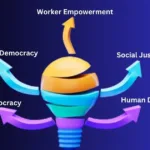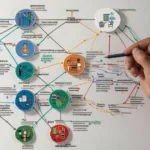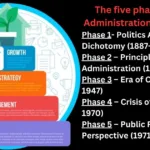Welcome to our System Approach to Public Administration. In this blog post, we’ll embark on a journey to uncover the principles and significance of this framework in modern governance. From understanding the intricate workings of organizational systems to dissecting the nuances between classical and system approaches, we’ll delve into the core concepts and practical implications that shape the landscape of public administration. So, join us as we navigate the complexities and opportunities the System Approach presents, shedding light on its role in fostering effective and efficient governance practices.
Contributions of Chester Barnard and Herbert Simon:
In the ever-evolving landscape of public administration, the System Approach stands out as a comprehensive framework that offers a holistic perspective on organizational dynamics and governance.
Rooted in the pioneering work of scholars like Chester Barnard and Herbert Simon, the System Approach emphasizes the interconnectedness of various components within administrative systems and the need to consider the system as a dynamic and adaptive entity.
In this blog post, we delve into the core principles, features, and practical implications of the System Approach to Public Administration.
From understanding organizations as cooperative systems to exploring the differences between classical and system approaches, we uncover the significance of systems thinking in navigating the complexities of modern governance.
Join us as we explore the System Approach’s strengths, weaknesses, and future prospects, and discover its role in shaping effective and responsive public administration practices.
Holistic and Dynamic Perspective
1. Definition and Overview:
The System Approach to Public Administration is a conceptual framework that views public organizations and administrative systems as interconnected and interdependent entities.
It considers the entire administrative structure as a system composed of various elements that work together to achieve common goals.
This approach emphasizes the relationships, interactions, and interdependencies among these elements rather than focusing solely on individual components in isolation.
In essence, it treats public administration as a complex system with inputs, processes, outputs, and feedback loops.
2. Historical Background:
The roots of the System Approach to Public Administration can be traced back to the mid-20th century when scholars and practitioners began to recognize the limitations of traditional approaches that predominantly focused on bureaucratic structures and hierarchical control.
Influential works by theorists such as Ludwig von Bertalanffy, who developed General Systems Theory in the 1940s, laid the foundation for this new perspective.
In the field of public administration, scholars like Chester Barnard, Herbert Simon, and Kenneth Arrow contributed significantly to the development of the System Approach by highlighting the need to understand organizations as dynamic and adaptive systems.
The rise of systems thinking in various disciplines, including management science and sociology, further bolstered the acceptance of this approach in public administration.
3. Importance in Modern Governance:
The System Approach holds significant importance in modern governance for several reasons:
i) Complexity Management: Public administration faces increasingly complex challenges in a rapidly changing global environment.
The System Approach provides a framework for managing this complexity by emphasizing the interconnectedness of various factors and the need for holistic solutions.
ii) Adaptability: Traditional bureaucratic models often struggle to adapt to changing circumstances.
The System Approach encourages flexibility and adaptability by recognizing that administrative systems are dynamic and must evolve to meet new demands and challenges.
iii) Interdisciplinary Perspective: Public administration intersects with various other fields, including economics, sociology, and political science.
The System Approach encourages an interdisciplinary perspective, allowing policymakers and administrators to draw insights from diverse disciplines to address complex governance issues effectively.
iv) Efficiency and Effectiveness: By understanding administrative systems as interconnected networks of components, the System Approach enables policymakers to identify inefficiencies, streamline processes, and improve overall effectiveness in delivering public services.
v) Enhanced Decision-Making: Viewing public administration through the lens of systems thinking enables policymakers to make more informed and strategic decisions.
By considering the broader context and the potential ripple effects of their actions, decision-makers can avoid unintended consequences and achieve better outcomes.
In summary, the System Approach to Public Administration offers a holistic and dynamic perspective that is essential for navigating the complexities of modern governance.
By recognizing the interconnectedness of administrative systems and emphasizing adaptability and interdisciplinary collaboration, this approach provides a valuable framework for addressing the multifaceted challenges faced by public organizations in the 21st century.
Organization as a Cooperative System:

In the realm of public administration, organizations are the engines that drive policy implementation, service delivery, and governance.
But have you ever considered these organizations as cooperative systems? In this blog post, we’ll explore the concept of “Organization as a Cooperative System” and uncover how collaboration and interconnectedness lie at the heart of effective organizational functioning.
From understanding the dynamics of organizational interactions to highlighting the importance of cooperation for achieving common goals, we’ll embark on a journey to illuminate the fundamental principles that underpin the cooperative nature of organizations in public administration.
So, let’s dive in and discover how viewing organizations as cooperative systems can enhance our understanding of their roles and functions in the public sector.
1. Understanding Organizations in Public Administration:
In public administration, organizations are the fundamental units responsible for implementing policies, delivering services, and managing public resources.
These entities range from government agencies and departments to non-profit organizations and international institutions.
Understanding organizations in public administration involves recognizing them as complex systems with multiple interconnected components.
2. Interconnectedness of Components:
Organizations in public administration comprise various interconnected components, including personnel, structures, processes, resources, and external stakeholders.
These components are not isolated entities but rather interact and influence each other within the organizational system. For example:
Personnel: Employees within an organization interact with each other, share information, and collaborate to accomplish common goals.
Structures: Organizational structures, such as hierarchies, departments, and divisions, determine how tasks are organized and how authority flows within the organization.
Processes: Workflow processes and procedures govern how tasks are performed and how decisions are made within the organization.
Resources: Resources, including financial, human, and technological resources, are allocated and managed to support the organization’s activities.
External Stakeholders: Organizations in public administration interact with external stakeholders, such as citizens, other government agencies, and interest groups, whose actions and interests influence the organization’s operations.
The interconnectedness of these components means that changes or disruptions in one area of the organization can have ripple effects throughout the entire system. For instance, a change in organizational structure may impact communication channels, workflow processes, and employee morale.
3. Cooperation for Effective Functioning:
Cooperation among the various components of an organization is essential for effective functioning in public administration.
Cooperation involves collaboration, communication, and coordination among individuals, departments, and external stakeholders to achieve common goals and objectives.
Here are some key aspects of cooperation within organizations:
Collaborative Decision-Making: Encouraging participation and input from multiple stakeholders in decision-making processes fosters a sense of ownership and ensures that decisions reflect diverse perspectives and expertise.
Effective Communication: Clear and open communication channels facilitate the exchange of information, ideas, and feedback within the organization, enabling employees to work together efficiently and align their efforts toward common objectives.
Coordination of Activities: Coordination ensures that different departments and units within the organization work in harmony to avoid duplication of efforts, minimize conflicts, and optimize resource utilization.
Partnerships with External Stakeholders: Collaborating with external stakeholders, such as community organizations, businesses, and government agencies, allows organizations to leverage external expertise, resources, and support to achieve shared goals and address complex challenges.
By fostering cooperation among its components, an organization can enhance its capacity to adapt to changing circumstances, innovate, and achieve desired outcomes effectively in the dynamic environment of public administration.
Differences between Classical Approach and System Approach
| Aspect | Classical Approach | System Approach |
|---|---|---|
| Perspective | Individualistic; Focus on Parts | Holistic; Focus on Interconnections and Dynamics |
| Structure | Hierarchical and Bureaucratic | Flexible and Adaptive |
| Goal Orientation | Efficiency and Stability | Adaptability and Sustainability |
| Communication | Top-Down Communication | Open Communication Channels |
| Decision-Making | Centralized Decision-Making | Decentralized Decision-Making |
| Feedback Mechanism | Limited or Absent | Emphasis on Feedback Loops |
1. Perspective:
- Classical Approach:
- The Classical Approach to public administration adopts an individualistic perspective, focusing primarily on the discrete parts or components of the administrative system. It emphasizes breaking down the organization into hierarchical structures and delineating specific roles and responsibilities for each individual within the organization.
- System Approach:
- In contrast, the System Approach takes a holistic perspective, viewing the administrative system as a dynamic and interconnected whole. It recognizes the interdependencies and interactions among various components of the system and emphasizes understanding the system’s overall behavior rather than focusing solely on individual parts.
2. Structure:
- Classical Approach:
- The Classical Approach tends to favor hierarchical and bureaucratic organizational structures characterized by clear lines of authority, formal rules and procedures, and centralized decision-making. This structure is designed to ensure stability and control within the organization.
- System Approach:
- Conversely, the System Approach promotes flexible and adaptive organizational structures that can respond effectively to changing environments and evolving demands. It recognizes that rigid bureaucratic structures may hinder innovation and adaptability and advocates for structures that can accommodate uncertainty and complexity.
3. Goal Orientation:
- Classical Approach:
- The Classical Approach typically prioritizes goals related to efficiency and stability. It aims to maximize productivity and minimize costs while maintaining organizational predictability and control.
- System Approach:
- In contrast, the System Approach places a greater emphasis on goals related to adaptability and sustainability. It acknowledges the dynamic nature of administrative systems and seeks to ensure that organizations can effectively respond to external changes, maintain resilience, and achieve long-term viability.
4. Communication:
- Classical Approach:
- Communication in the Classical Approach tends to be top-down, with information flowing primarily from higher levels of authority to lower levels. Decision-makers at the top of the hierarchy dictate instructions and directives that are then implemented by subordinates.
- System Approach:
- The System Approach advocates for open communication channels that facilitate the exchange of information, ideas, and feedback across all levels of the organization. It recognizes the importance of fostering a culture of transparency, collaboration, and participatory decision-making.
5. Decision-Making:
- Classical Approach:
- Decision-making in the Classical Approach is often centralized, with key decisions made by a small group of individuals at the top of the organizational hierarchy. This approach aims to maintain control and ensure consistency in decision-making processes.
- System Approach:
- In contrast, the System Approach promotes decentralized decision-making, distributing decision-making authority across various levels and units within the organization. This allows for greater responsiveness to local conditions, encourages innovation, and empowers employees to take ownership of their work.
6. Feedback Mechanism:
- Classical Approach:
- Feedback mechanisms in the Classical Approach may be limited or absent, with little emphasis placed on gathering and incorporating feedback from stakeholders. This can result in a lack of responsiveness to changing circumstances and missed opportunities for improvement.
- System Approach:
- The System Approach places a strong emphasis on feedback loops, recognizing them as essential for monitoring performance, identifying issues, and making necessary adjustments. By actively seeking and integrating feedback from stakeholders, organizations can continuously improve their processes and outcomes.
In summary, while the Classical Approach tends to adopt a more rigid and individualistic perspective, focusing on stability and control, the System Approach offers a more holistic and flexible framework that emphasizes adaptability, collaboration, and continuous improvement.
Closed System: Definition and Characteristics:

A Closed System is a self-contained entity that does not interact with its environment. In a closed system, all activities and processes are internal, and there is no exchange of matter, energy, or information with the external environment. Characteristics of a Closed System include:
- Isolation: Closed systems are isolated from their surroundings, meaning they do not interact with external entities or environments.
- Limited Input: They have limited or no input from the external environment. All resources and inputs needed for operation are self-contained within the system.
- Fixed Boundaries: Closed systems have clearly defined boundaries that separate them from the external environment. These boundaries remain constant and do not change over time.
- Stability: Because closed systems are not influenced by external factors, they tend to maintain a stable internal state unless acted upon by an external force.
- Limited Adaptability: Closed systems have limited capacity for adaptation or change since they are not influenced by external feedback or stimuli.
Open System: Definition and Characteristics:
An Open System is a dynamic entity that interacts with its environment through exchanges of matter, energy, and information. In an open system, there is a continuous flow of inputs and outputs between the system and its external environment. Characteristics of an Open System include:
- Interaction with Environment: Open systems interact with their external environment, exchanging resources, energy, and information to maintain their functioning.
- Continuous Input and Output: They continuously receive inputs from the environment, process these inputs internally, and produce outputs that are released back into the environment.
- Dynamic Boundaries: Open systems have flexible boundaries that allow for the exchange of materials, energy, and information with the environment. These boundaries may expand or contract depending on the system’s needs and the demands of the environment.
- Adaptability: Open systems are adaptable and responsive to changes in the environment. They can adjust their internal processes and structures in response to external feedback and stimuli.
- Complexity: Open systems tend to be more complex than closed systems due to their interactions with the environment and the diversity of inputs they receive.
Examples from Public Administration:
Examples of Closed Systems and Open Systems in Public Administration can help illustrate these concepts:
- Closed System: A government agency that operates in isolation from external stakeholders and does not seek input or feedback from citizens or other government agencies can be considered a closed system. It relies solely on internal processes and procedures to carry out its functions and does not adapt or respond to external changes.
- Open System: In contrast, a public-private partnership (PPP) that involves collaboration between a government agency and private companies to deliver public services is an example of an open system. The partnership interacts with various stakeholders, including citizens, businesses, and other government agencies, to exchange resources, expertise, and information in order to achieve common goals. The partnership is adaptable and responsive to changes in the external environment, such as shifts in market conditions or regulatory requirements.
Overall, understanding the distinction between closed and open systems is crucial for analyzing and designing effective administrative systems in public administration, as it highlights the importance of interaction, adaptability, and responsiveness to external influences.
Feature of the System Approach:

1. Interconnectedness:
Interconnectedness is a fundamental feature of the System Approach, emphasizing the idea that various components within a system are interconnected and interdependent.
This means that changes or actions in one part of the system can have ripple effects on other parts.
In public administration, interconnectedness highlights the relationships between different departments, units, and stakeholders within an organization, as well as the connections between the organization and its external environment.
Recognizing interconnectedness allows policymakers and administrators to understand how changes or interventions in one area may impact the overall functioning and performance of the administrative system.
2. Feedback Mechanisms:
Feedback mechanisms are essential components of the System Approach, enabling systems to monitor and regulate their performance by receiving and responding to feedback from their environment.
Feedback mechanisms involve gathering information about the system’s outputs and comparing them with desired outcomes or goals.
This information is then used to make adjustments or corrections to the system’s inputs or processes to improve performance.
In public administration, feedback mechanisms can take various forms, including performance evaluations, stakeholder surveys, and public consultations.
By incorporating feedback loops, policymakers and administrators can ensure that administrative systems remain responsive, adaptive, and effective in achieving their objectives.
3. Adaptability:
Adaptability refers to the ability of a system to adjust and respond effectively to changes in its environment or circumstances.
Systems that exhibit adaptability can modify their structures, processes, and behaviors to accommodate new challenges, opportunities, or demands.
In public administration, adaptability is crucial for addressing dynamic and evolving governance issues, such as technological advancements, demographic shifts, and changing policy priorities.
An adaptable administrative system can innovate, experiment, and learn from experiences to improve its performance and outcomes over time.
4. Goal Orientation:
Goal orientation entails aligning the activities and efforts of a system toward achieving specific objectives or outcomes.
In the System Approach, goal orientation emphasizes the importance of defining clear and measurable goals that guide the system’s activities and decision-making processes.
These goals serve as benchmarks for evaluating the system’s performance and effectiveness.
In public administration, goal orientation helps policymakers and administrators prioritize actions, allocate resources, and monitor progress toward desired policy outcomes, such as improved service delivery, enhanced citizen satisfaction, or increased efficiency.
5. Dynamic Nature:
The dynamic nature of the System Approach acknowledges that systems are not static entities but rather evolve and change over time in response to internal and external influences.
Dynamic systems are characterized by continuous interactions, adjustments, and transformations as they adapt to new conditions or circumstances.
In public administration, the dynamic nature of administrative systems underscores the need for flexibility, innovation, and continuous improvement.
Policymakers and administrators must be prepared to anticipate and respond to emerging challenges and opportunities by adjusting policies, strategies, and practices to meet evolving needs and expectations.
In summary, the System Approach to public administration encompasses features such as interconnectedness, feedback mechanisms, adaptability, goal orientation, and a dynamic nature, which together provide a comprehensive framework for understanding and managing complex administrative systems in an ever-changing environment.
Recognizing and leveraging these features can help policymakers and administrators design more effective and responsive governance structures and processes to address contemporary challenges and achieve desired policy outcomes.
Strengths of the System Approach:

1. Holistic Perspective:
One of the primary strengths of the System Approach is its holistic perspective, which recognizes the interconnectedness and interdependencies among various components of the administrative system.
This holistic view allows policymakers and administrators to understand complex systems in their entirety and identify systemic solutions to governance challenges.
2. Adaptability:
The System Approach emphasizes adaptability, enabling administrative systems to respond effectively to changes in their environment.
By fostering flexibility and resilience, the System Approach helps organizations navigate uncertainty and volatility while maintaining their effectiveness and relevance over time.
3. Feedback Mechanisms:
Incorporating feedback mechanisms is another strength of the System Approach.
By establishing feedback loops, administrative systems can continuously monitor their performance, identify areas for improvement, and make necessary adjustments to enhance their effectiveness and efficiency.
4. Goal Orientation:
The System Approach promotes goal orientation, ensuring that administrative systems are aligned with overarching policy objectives and outcomes.
This goal-oriented approach helps policymakers and administrators prioritize actions, allocate resources, and measure progress toward achieving desired policy outcomes.
Weaknesses and Limitations:
1. Complexity:
One of the main challenges of the System Approach is its complexity.
Analyzing and managing interconnected systems with multiple components can be daunting, requiring significant time, resources, and expertise.
Complexity can hinder implementation and increase the risk of unintended consequences or system failures.
2. Resource Intensive:
Implementing the System Approach often requires substantial investments in technology, training, and organizational restructuring.
Small or resource-constrained organizations may struggle to adopt and sustain this approach, limiting its applicability and effectiveness in certain contexts.
3. Resistance to Change:
Resistance to change is another limitation of the System Approach.
Bureaucratic inertia, entrenched interests, and organizational culture may impede efforts to introduce systemic reforms or innovations, hindering the adoption and implementation of the System Approach.
4. Uncertainty and Ambiguity:
The dynamic nature of administrative systems introduces uncertainty and ambiguity, making it challenging to predict outcomes or assess the effectiveness of interventions.
This uncertainty can complicate decision-making and evaluation processes, undermining confidence in the System Approach.
Practical Implications in Public Administration:
1. Policy Design and Implementation:
The System Approach provides policymakers with a framework for designing and implementing policies that consider the interconnectedness of various stakeholders and factors.
By taking a systems perspective, policymakers can develop more effective and sustainable solutions to complex governance challenges.
2. Organizational Management:
In public administration, the System Approach can inform organizational management practices by emphasizing adaptability, collaboration, and continuous improvement.
Administrators can use feedback mechanisms to monitor organizational performance, identify areas for improvement, and enhance decision-making processes.
3. Service Delivery:
Applying the System Approach to service delivery can help improve the quality, efficiency, and responsiveness of public services.
By understanding the systemic factors that influence service delivery, policymakers and administrators can design interventions that address root causes and improve outcomes for citizens.
Future Prospects and Research Directions:
1. Integration of Technology:
Future research could explore the integration of emerging technologies, such as artificial intelligence and data analytics, into the System Approach.
Leveraging technology can enhance the capacity of administrative systems to collect and analyze data, predict trends, and optimize decision-making processes.
2. Cross-Sectoral Collaboration:
There is a need for further research on cross-sectoral collaboration and partnership models within the System Approach.
Examining successful examples of collaboration between government, private sector, and civil society actors can provide insights into effective strategies for addressing complex governance challenges.
3. Resilience and Sustainability:
Future research could focus on enhancing the resilience and sustainability of administrative systems within the System Approach.
This includes exploring strategies for building adaptive capacity, managing risks, and promoting long-term sustainability in the face of environmental, economic, and social changes.
In conclusion, while the System Approach offers several strengths and practical implications for public administration, it also faces challenges and limitations that must be addressed.
By critically evaluating its strengths and weaknesses and identifying areas for future research and innovation, policymakers and researchers can continue to refine and enhance the System Approach to meet the evolving needs of governance in the 21st century.
Conclusion:
In conclusion, the System Approach to Public Administration offers a significant framework for understanding and managing complex administrative systems.
Through its holistic perspective, emphasis on adaptability, and integration of feedback mechanisms, the System Approach provides policymakers and administrators with valuable tools for addressing contemporary governance challenges.
By recognizing the interconnectedness of various components within administrative systems and promoting goal orientation, the System Approach helps organizations align their efforts with overarching policy objectives and outcomes.
Recap of System Approach’s Significance:
The System Approach’s significance lies in its ability to:
- Provide a holistic perspective on administrative systems.
- Foster adaptability and resilience in the face of changing environments.
- Incorporate feedback mechanisms to monitor performance and improve decision-making.
- Align organizational efforts with overarching policy goals and objectives.
Call to Action for Further Exploration:
As we move forward, there is a need for further exploration and refinement of the System Approach in public administration. Policymakers, researchers, and practitioners are encouraged to:
- Explore innovative applications of the System Approach in different governance contexts.
- Investigate strategies for overcoming challenges and limitations associated with the approach.
- Collaborate across sectors and disciplines to develop comprehensive solutions to complex governance challenges.
- Invest in research and capacity-building initiatives to enhance understanding and implementation of the System Approach.
Closing Thoughts:
In conclusion, the System Approach offers a promising framework for addressing the complexities of modern governance.
By embracing its principles and methodologies, policymakers and administrators can enhance the effectiveness, efficiency, and responsiveness of administrative systems, ultimately improving outcomes for citizens and society as a whole.
As we continue to navigate the dynamic landscape of public administration, let us remain committed to exploring and refining the System Approach to meet the evolving needs and challenges of governance in the 21st century.
Frequently Asked Questions (FAQs) :
1. What is the System Approach to Public Administration?
- The System Approach is a conceptual framework that views administrative systems as interconnected and interdependent entities, emphasizing holistic understanding, adaptability, and feedback mechanisms.
2. How does the System Approach differ from traditional approaches to public administration?
- Unlike traditional approaches that focus on individual parts or components, the System Approach considers the entire administrative system as a dynamic and interconnected whole, emphasizing relationships, interactions, and adaptability.
3. What are the key features of the System Approach?
- The key features include interconnectedness, feedback mechanisms, adaptability, goal orientation, and a dynamic nature.
4. How does the System Approach benefit public administration?
- The System Approach helps policymakers and administrators better understand complex administrative systems, make more informed decisions, enhance adaptability and responsiveness, and improve overall governance outcomes.
5. What are some examples of the System Approach in action?
- Examples include the adoption of collaborative decision-making processes, implementation of performance feedback mechanisms, and development of flexible organizational structures in public administration.
6. What are the challenges associated with implementing the System Approach?
- Challenges may include complexity, resource constraints, resistance to change, and uncertainty about outcomes. Overcoming these challenges requires strategic planning, stakeholder engagement, and capacity-building efforts.
7. How can organizations apply the System Approach in practice?
- Organizations can apply the System Approach by promoting collaboration, integrating feedback mechanisms, setting clear goals, fostering adaptability, and embracing a culture of continuous improvement.
8. What are some future research directions for the System Approach?
- Future research could explore the integration of emerging technologies, cross-sectoral collaboration models, and strategies for enhancing resilience and sustainability within the System Approach.
9. How can policymakers and administrators learn more about the System Approach?
- Policymakers and administrators can learn more about the System Approach through training programs, workshops, conferences, and professional networks dedicated to systems thinking and public administration.
10. What role can citizens play in supporting the adoption of the System Approach?
- Citizens can support the adoption of the System Approach by advocating for transparent, inclusive, and participatory governance processes that prioritize feedback, collaboration, and responsiveness to community needs.
These FAQs provide additional information and clarification on key concepts discussed in the blog post, addressing common questions that readers may have about the System Approach to Public Administration.
References:
Online References:
1. Bertalanffy, L. von. (1968). General System Theory: Foundations, Development, Applications. Retrieved from https://doi.org/10.1126/science.160.3827.897
2. Simon, H. A. (1947). Administrative Behavior: A Study of Decision-Making Processes in Administrative Organization. Retrieved from https://doi.org/10.2307/2251186
3. “Systems Approach to Public Administration.” Encyclopedia.com. Retrieved from https://www.encyclopedia.com/politics/encyclopedias-almanacs-transcripts-and-maps/systems-approach-public-administration
4. Frederickson, H. G. (1987). Public Administration and the Art of the Possible. Public Administration Review, 47(4), 364-365. Retrieved from https://doi.org/10.2307/976595
5. Dror, Y. (2005). Public Policy Making Reexamined. Policy Sciences, 38(4), 287-313. Retrieved from https://doi.org/10.1007/s11077-005-5051-5
Offline References:
1. Rosenbloom, D. H., & Kravchuk, R. S. (2012). Public Administration: Understanding Management, Politics, and Law in the Public Sector. New York, NY: McGraw-Hill Education.
2. Kickert, W. J. M., Klijn, E. H., & Koppenjan, J. F. M. (Eds.). (1997). Managing Complex Networks: Strategies for the Public Sector. London, UK: Sage Publications.
3. Waldo, D. (1987). The Administrative State: A Study of the Political Theory of American Public Administration. New York, NY: Holmes & Meier Publishers.
4. Thompson, J. D. (1967). Organizations in Action: Social Science Bases of Administrative Theory. New Brunswick, NJ: Transaction Publishers.
5. Hood, C. (1991). A Public Management for All Seasons? Public Administration, 69(1), 3-19.
People Also Read: Behavioral Approach to Public Administration











